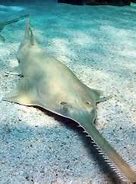In the Florida Keys, multiple species of fish, including the endangered sawfish, were swimming in circles until they died suddenly. Smalltooth Sawfish are an endangered species of sawfish that inhabit Florida waters. In November of 2023, residents of the Keys observed both fish and stingrays spinning in circles, often until they died. Florida scientists recorded this in more than 80 species of fish. The Sawfish species was impacted the hardest in losses. Universities and non-profit organizations and governmental agencies teamed up to try to figure out why and how to stop it before decades of conservation efforts for the Smalltooth Sawfish could be set back. As of Saturday, September 7th of 2024, part of the answer was finally found.
After multiple water tests, the culprit turned out to be something usually only found in the algae dinoflagellates (one-celled aquatic organisms) genus of Gambierdiscus, which releases toxins. They usually stay on sea grass near the sea floor but ended up in the waters. The spinning disease was caused by this and other species of dinoflagellates. The fish were exposed to these toxins for an extended amount of time. No less than 54 rays succumbed to the odd spinning phenomenon, with scientists saying that they no doubt died due to the toxins, according to Bethany Augliere, National Geographic Writer.
The toxins were found in the liver rather than stomach, which suggested that there were other types of dinoflagellates that the fish were being exposed to. Though it is now known what caused it, it is unknown why it caused the fish to spin as the discovered toxins are usually only harmful to humans, giving them a foodborne illness that causes vomiting, as well as changes to body temperature.
Alison Robertson, a marine scientist who studies harmful algal blooms at the University of South Alabama’s Stokes School of Marine and Environmental Sciences and the Dauphin Island Sea Lab, said “It’s just really rare, we’ve never really seen that, this is what we have to work out.”
It is also a mystery why the endangered Smalltooth Sawfish were impacted so hard compared to other species, or how the toxins got from the algae to free roaming in the water. It is hoped that they can fully determine these reasons as soon as possible.













